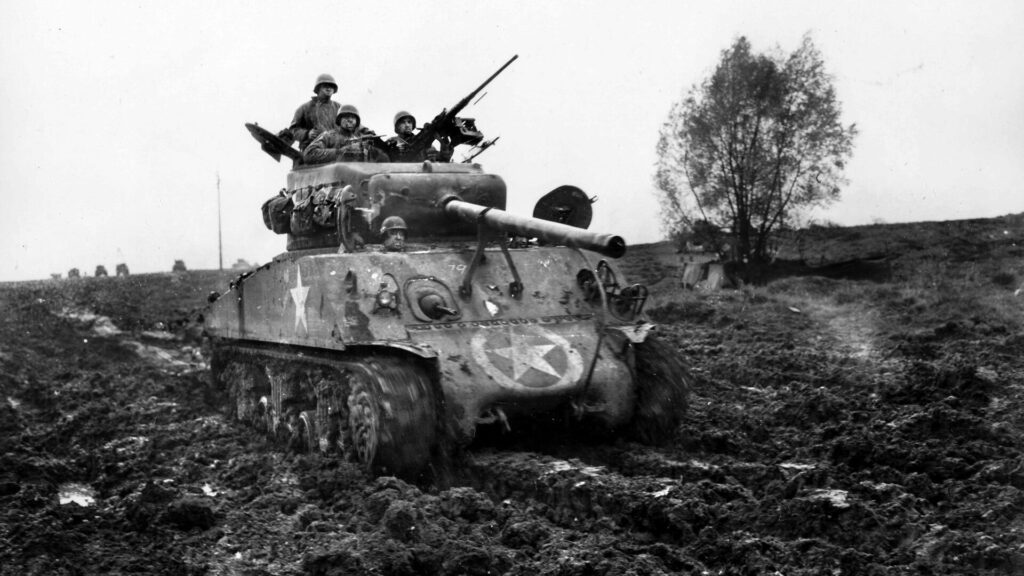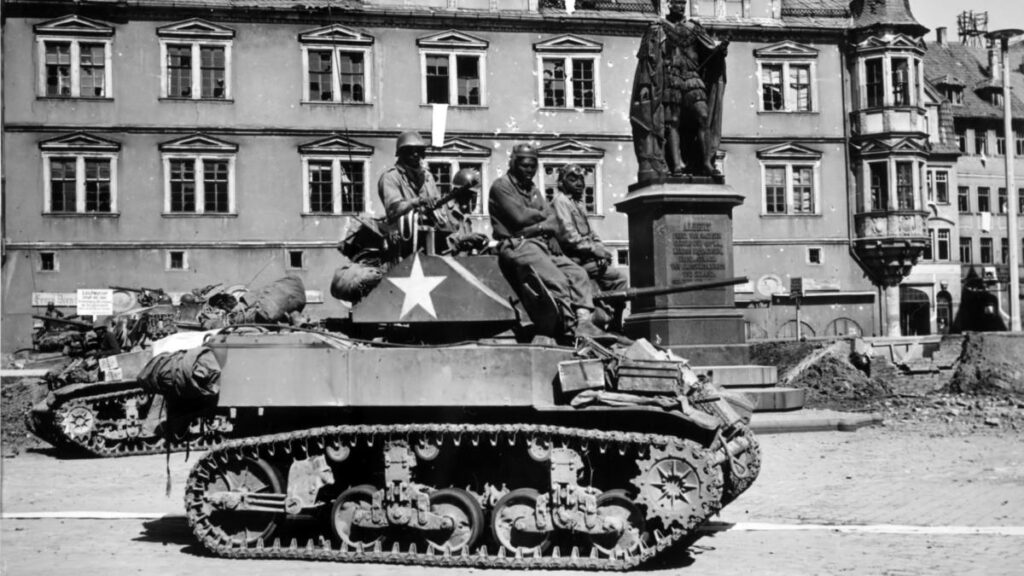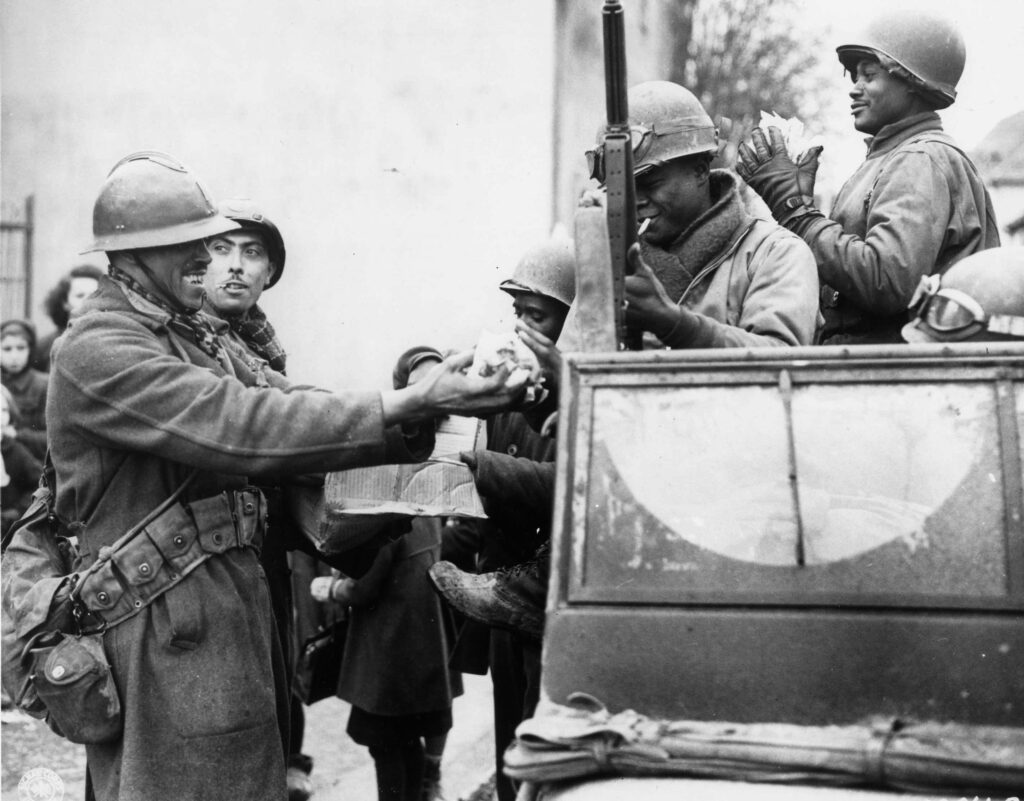Entry of the United States into World War II quickly revealed how woefully ill-prepared the armed forces were to contend with a major conflict. Apart from the peacetime draft instituted in 1940 and lend-lease support to Great Britain few actions had been taken to address escalating global tensions. Now racing to enlist, train, arm and deploy resources necessary across multiple theatres of war the Army and other branches of service were forced to again face long-held racial discrimination and related practices. Responding to arguments raised by General McNair, Commander of Army Ground Forces, the US began to experiment with segregated combat units in 1941 and as one outcome, the 761st Tank Battalion was activated April 1, 1942. Rated Superior during training by Lt. General Lear, Commander Second Army, the unit fought with distinction across the European Theatre of Operations (ETO) as the first Black tank battalion to enter combat, eventually adopting the nickname Black Panthers, and is celebrated as one of the most effective armored battalions in WWII.


“Come Out Fighting”
Constituted at Camp Claiborne, Louisiana the 761st was overwhelmingly comprised of inductees from deep southern states. Having experienced a lifetime of racism and institutional segregation these recruits carried with their attitudes and personal values familiar only to other racially segregated units, at times leading to physical and then lawless confrontation.

Perhaps the most well-known action was the refusal by a young second lieutenant and morale officer, Jackie Robinson, to move to the back of a bus while on base, causing his immediate court-martial and eventual acquittal following WWII. In the face of extreme scrutiny both as soldiers and tankers, the Battalion’s success is credited in large measure to the command of Lt. Colonel Paul Bates who closely guided and challenged the men to strive for excellence, and in doing so realize their potential. Following twenty-four months of training involving light-duty Stuart tanks (Camp Claiborne) and the iconic medium-duty M4 Sherman (Fort Hood, Texas), the 761st was said to exhibit exceptional morale as they embarked for the ETO from New York on August 27, 1944.
The Battalion arrived in England and underwent final training before entering the ETO through Omaha Beach on October 10, 1944. Then totaling 712 (36 officers and 676 enlisted men) and organized into five companies the Battalion was transported to bivouac at La Pieux, France and immediately assigned to General Patton’s 3rd Army, at his request. Characteristically, Patton addressed the men from the back of a half-track.

“Men, you’re the first Negro tankers to ever fight in the American Army. I would never have asked for you if you weren’t good. I have nothing but the best in my Army. I don’t care what color you are as long as you go up there and kill those Kraut sonsofbitches. Everyone has their eyes on you and is expecting great things from you. Most of all your race is looking forward to your success. Don’t let them down and damn you, don’t let me down! They say it is patriotic to die for your country. Well, let’s see how many patriots we can make out of those German sonsofbitches.”

Attached to the 26th Infantry Division, the 761st Tank Battalion would need to catch the 3rd Army in a race across Europe that began August 1944, following Operation Cobra. On November 7, 1944, the Battalion moved on the towns of Moyenvic and Vic-Sur-Seille that would prove to be their baptism in combat, and following two days of savage fighting Moyenvic, Bezenge-la-Petite and Hill 253 fell. To continue the advance the 26th Division formed a Provisional Task Force with the 761st as spearhead, heading northward toward Morville, France under heavy enemy artillery and mortar fire. Morville was taken on November 9th and Wuisse on the 11th, Kerpriche and Dreuze fell November 20th with Bossing, Bidestroff, Inswiller, Torcheville, Nebing, and Neufvillage taken by tank-infantry teams by November 25th. Then entering Honskirch, France on November 25th the 761st was forced to withdraw and instead advance through Sarre Union that fell on December 2nd.
Brilliant Performance 761st Tank Battalion
In less than one month the 761st Tank Battalion entered combat and performed brilliantly in liberating over fifteen towns. Moreover, for his leadership and “extraordinary heroism in action” during this advance Sargent Rubin Rivers posthumously received the Congressional Medal of Honor. However, the price paid for this success during November 1944 alone included 22 killed in action, 125 casualties, 14 tanks of the original 54 lost and 20 severely damaged. As December unfolded, the 3rd Army was poised to cross the border from France into Germany. But no one could conceive of what was in store for the 761st.

On December 14, 1944, the 761st Battalion spearheaded 3rd Army’s advance past the Maginot Line and crossed into Germany between Saarbrucken and Strasbourg, steeling themselves for an assault on the Siegfried Line. However, these plans would wait as the Germans launched the Ardennes counteroffensive between Belgium and Luxembourg on December 16th, later popularized as the Battle of the Bulge. In response, the 761st moved immediately to Offagne, Belgium, only thirty miles southwest of Bastogne. Supporting the 345th Infantry Regiment the towns of Rondu and Nimbermont, Belgium fell and following two days of intensive fighting Tillet was taken from the 113th Panzer Brigade on December 31st. Critical to Allie’s success, Tillet was an epic assault conducted with eleven tanks, but only two survived the battle. The Battalion then seized and held roads leading to and from Bastogne, captured six more towns in conjunction with the 17th Airborne Division, engaged and defeated an enemy column near Emmerscheid, and once again crossed into Germany on January 31, 1945.

The Battle of the Bulge was now over and battle lines reestablished, priority once again became infiltration into Germany. Now February 1945, the 761st Battalion was reassigned to US 9th Army, supporting the 314th Regiment in capturing two more cities, clearing pockets of resistance and supporting the 79th Division in attacks conducted along the Roer River. The Battalion was again reassigned in March to the 7th Army (103rd Infantry Division), replacing the 48th Tank Battalion and spearheading Task Force Cactus in assaulting and breaching the Siegfried Line, opening the way for the U.S. 4th Armored Division into Germany. Leveraging earlier rapid advancement of the 761st, the unit was assigned to Task Force Rhine organized on March 21st and composed of the 761st Tank Battalion, 409th Infantry Regiment and an Engineer Detachment. Assembling in Riesdorf, two columns proceeded north, clearing pillboxes and capturing five towns before seizing the mission objective of Klingen-Munster on March 23rd. The way now open for the 14th Armored Division into Germany, the 761st was reassigned to 3rd Army and crossed the Rhine themselves at Oppenheim on March 30th.

During ensuing months, the 761st supported the US 71st Division in the capture of the entire 6th SS Mountain Division, smashed through dozens of German cities and towns, and in the final days of the war in Europe was one of the first American units to reach Steyr, Austria, at the Enns River. There they met with the 1st Ukrainian Front of the Soviet Red Army. During combat operation in World War II front line troops rarely spent more than a few weeks on the front lines; however, much to the contrary the 761st had been in combat since their arrival in the ETO– over 183 days straight.

On May 4th, 1945, the 761st Tank Battalion and 71st Infantry Division unexpectedly encountered something that would haunt the men for the rest of their lives, the Gunskirchen Concentration Camp. A subcamp of the infamous Mauthausen network, the guards had fled several days earlier and left over 15,000 souls behind.

The 761st Tank Battalion Was Awarded the Presidential Unit Citation
The 761st was deactivated on June 1, 1946 in Germany.

The 761st Tank Battalion bore a weight that few can understand, performing brilliantly throughout the war in Europe and credited with inflicting over 130,000 enemy casualties. In tribute to the men of the 761st Tank Battalion, on January 24, 1978, President Jimmy Carter belatedly awarded the Presidential Unit Citation that had earlier eluded them. In further tribute, on November 7, 2015 the American Veterans Center in Washington DC conferred the Audie Murphy Award for “…men of valor on and off the battlefield”. In truth, we owe these men a debt that can never be repaid.
Read About Other Famous Military Units
If you enjoyed learning about 761st Tank Battalion, we invite you to read about other profiles in courage on our blog. You will also find military book reviews, veterans’ service reflections and more on the TogetherWeServed.com blog. If you are a veteran, find your military buddies, view historic boot camp photos, build a printable military service plaque, and more on TogetherWeServed.com today.

I would like to find out if my uncle Edward Gailes was a member of the 761st